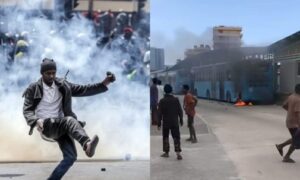For many years, Al Shabaab was confined within the borders of Somali, fighting against foreign inference and the western backed government of Somali with the hope of taking over and instituting Islamic Law in the Horn of Africa.
Following consecutive entry and kidnapping of Tourists from the coast of Kenya, Operation Linda Nchi was launched, sending Kenyan troops to the heart of Al-Shabaab October 2010.
The al-Shabaab war changed and Kenyans became a target of multiple attacks. Al-Shabaab commanders led by the late Ahmed Abdi Godane aka Mukhtar Abu Zubair initiated series of attacks against Kenyan citizens.
In an interview with Al Jazeera, Sheikh Ali Mohamud Rage, the 2014 spokesperson of the militant group said:
“What happened in Mandera today we did in revenge for what the non-believer government has done to innocent Muslims.”
This was after the Al-Shabaab attacked Garissa University killing 148 people and injuring 79.
Al-Shabaab narrative
The organization first came up in 2006. By 2007 the group had become active after March 26, 2007 attacks when Adam Salaam Adam, a car bomber killed 73 people in a suicide car bombing against Ethiopian troops in Mogadishu.
Al-Shabaab is an Arabic word that means “The Youth” coming up as a break away organization from Islamic Courts Union with the support of Al Qaida.
Aden Hashi Ayro is recorded as its first leader. He had previously helped created Al Ittihad Al Islamiya (AIAI) in 1991.
Since then, the organization has been growing more and more active in terrorism and control over Somali.
Deadly attacks
October 29, 2008: suicide bombings in cities of Hargeisa and Bosasso within Somali where they killed more than 29 people and wounded 26.
July 11, 2010: simultaneous attacks in Kampala Uganda and Addis Ababa Ethiopian restaurant killing in total 74 people and wounding 85 more.
September 21, 2013: Westgate Mall Attacks. Worst terror attack in Kenya since the US embassy bombing of 1998. The four days siege ended in 68 deaths and 175 wounded Kenyans.
The attack horrified the world and exposed the ever lingering terrorism threat.
April 2015: Garissa University attacks. The siege in north eastern Kenya University College killed 148 Kenyans, most of whom were students.
January 15, 2016: Al-Shabaab militants overrun Amisom base at El-Ade within Somali. The attack that included suicide bombers and gunmen led to death of numerous Kenya Defense Forces (KDF) officers.
Though the government of Kenya did not release the actual number of officers lost, al-Shabaab propaganda said that they killed over 15o soldiers.
October 14, 2017: In what has been termed as Somali’s 9/11, two truck bombs are detonated in a busy Mogadishu street, killing 512, wounding 312 and 62 people remain missing to date.
January 15, 2019: The 19 hours siege on DusitD2 hotel in Nairobi as a retaliation to increased airstrikes by US military in Somalia killing 21 people and scores others wounded.
Recent attacks
Towards the end of 2019 and January 2020, Al Shabaab has intensified its attacks in Kenya. Ten people were killed when the gunmen attacked Medina Bus Company’s bus in Kotulo area near Wajir. Three Americans including a member of US army died during the Manda Bay attack.
The militants killed four school children following an attack in Mandera among others.
Do you have a story you would like us to publish? Please reach us through info@gotta.news or call/SMS +254 731 469269

















